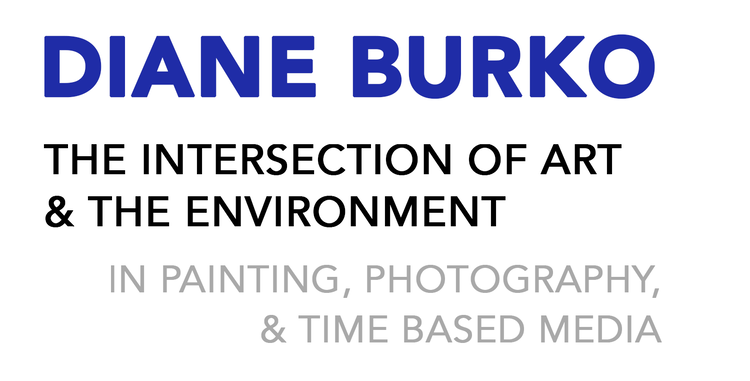
Introduction by Dr. Alexandra Rahr on the occasion of a talk given by Diane Burko at the University of Toronto to the Environmental Humanities Working Group on October 12th, 2018
It's a particular pleasure to welcome our guest today to the EHN - Diane Burko is a renowned artist and activist and she's here today to speak to us about the conjunctions between those two roles.
I think it's fair to say that Diane has long been fascinated by landscapes. Her remarkable work re-imagines the long, venerable and - as we know as environmental humanists - troubled painterly landscape tradition. Her images shake up, interrogate and destabilize the pastoral ideal. Countering the familiar nostalgic romance of an American Eden - that is such a persistent element in the republic's artistic heritage - Diane's work instead gives us a very different view of the aesthetic world.
Turning away from the longing, backward-looking glance, Diane's work is insistently present: she creates landscapes of the now - of the right now - and even of the American environmental future: of the already made, already determined, but somehow not yet quite wholly visible. Truly, she shows us the Anthropocene. In all its urgent futurity and its present immediacy.
As you know, Diane makes us see in a very particular way: she brings together the seemingly disparate practices of art and science. Her work treats data like chiarascuro, like POV, like a vanishing point: like an essential artistic methodology or material.
And so, projects like the much lauded 'Politics of Snow' show us climate change by way of incorporation: by making art and activism out of geological fact. And the conjoining of statistics and image, of information and painterly skill, is activism as well as fine art.
We are lucky indeed to have her here today, and to share with us her journey 'from landscape artist to explorer activist.'

Introduction by Dr. Alexandra Rahr on the occasion of a talk given by Diane Burko at the University of Toronto to the Environmental Humanities Working Group on October 12th, 2018
It's a particular pleasure to welcome our guest today to the EHN - Diane Burko is a renowned artist and activist and she's here today to speak to us about the conjunctions between those two roles.
I think it's fair to say that Diane has long been fascinated by landscapes. Her remarkable work re-imagines the long, venerable and - as we know as environmental humanists - troubled painterly landscape tradition. Her images shake up, interrogate and destabilize the pastoral ideal. Countering the familiar nostalgic romance of an American Eden - that is such a persistent element in the republic's artistic heritage - Diane's work instead gives us a very different view of the aesthetic world.
Turning away from the longing, backward-looking glance, Diane's work is insistently present: she creates landscapes of the now - of the right now - and even of the American environmental future: of the already made, already determined, but somehow not yet quite wholly visible. Truly, she shows us the Anthropocene. In all its urgent futurity and its present immediacy.
As you know, Diane makes us see in a very particular way: she brings together the seemingly disparate practices of art and science. Her work treats data like chiarascuro, like POV, like a vanishing point: like an essential artistic methodology or material.
And so, projects like the much lauded 'Politics of Snow' show us climate change by way of incorporation: by making art and activism out of geological fact. And the conjoining of statistics and image, of information and painterly skill, is activism as well as fine art.
We are lucky indeed to have her here today, and to share with us her journey 'from landscape artist to explorer activist.'
